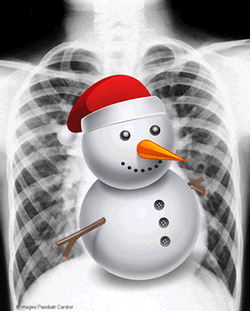Snowman sign
|
The “snowman sign” is a particular image on a chest X-Ray image, which is seen in anomalous pulmonary venous drainage and coarctation of the aorta which causes a Total Anomalous Pulmonary Venous Return (TAPVR). This abnormality occurs when the pulmonary veins fail to drain into the left atrium and instead form an aberrant connection with some others cardiovascular structures. Such abnormalities account for approximately 2% of cardiac malformations. There are four types of TAPVR; type 1 is the most common (and the one that creates the snowman sign). In this case the pulmonary veins terminate at the supracardiac level, emptying into the right atrium by way of an anomalous pulmonary venous drainage into the superior vena cava (SVC), and the left brachiocephalic vein (by way of a vertical vein). The confluence of these veins dilates the right brachiocephalic vein, which appears as a dilated vessel on the right of the upper mediastinal edge. When seen in an AP Chest X-Ray, the TAPVAR type 1, resembles a snowman; the dilated vertical vein on the left, the right brachiocephalic vein superiorly, and the SVC on the right form the head of the snowman, the body is formed by the enlarged right atrium. Article written by: Prof. Claudio R. Molina, MsC. |
|
| Sources: 1. Emma C. Ferguson, Rajesh Krishnamurthy, and Sandra A. A. Oldham. (2007) Classic Imaging Signs of Congenital Cardiovascular Abnormalities. RadioGraphics 27:5, 1323-1334. 2. Somerville, J., & Grech, V. (2009). The chest x-ray in congenital heart disease 1. Total anomalous pulmonary venous drainage and coarctation of the aorta. Images in Paediatric Cardiology, 11(1), 7–9. |
|
| Back to MTD Main Page | Subscribe to MTD |
